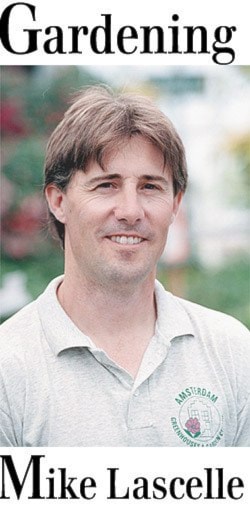There was a time back in the 1940s and ’50s when German bearded iris and its many hybrids were standard fare in residential gardens.
These reliable perennials were easily divided and shared with friends or family at a time when there wasn’t a lot of disposable income to spend at the few garden centres that existed in those days.
But over the years, this old-fashioned flower seemed to fall out of favour, to the point where I rarely planted it as a landscaper back in the 1980s and ’90s.
Thankfully, gardeners seem to have rediscovered the dramatic beauty and diverse colour range of this easy-to-grow perennial, as it see it popping up in landscapes throughout Maple Ridge and Pitt Meadows.
Although most of what we see are the tall bearded irises (taller than 28”), there are several height classifications of iris germanica, including miniature, standard and intermediate.
The huge blooms are often bicolored with the upper three petals being referred to as the ‘standards,’ the cascading lower three the ‘falls,’ and the fuzzy tuft at the base of the lower petals the ‘beard’.
The flowering season generally runs from May to June with each plant blooming a few weeks, although repeat-bloomers are also available.
German bearded irises prefer at least six hours of direct sun and require a well-drained soil with a neutral pH between 6.8 and seven, which means that you should probably incorporate some dolomite lime to our often acidic soils to sweeten them up.
They really are trouble-free except for division, which should occur every three to four years in late summer – neglecting this task will only result in spindly plants with few flowers.
The best planting time for new rhizomes runs from late July to early October, as they will need to root in before they face their first frosts.
Care should be taken not to bury the rhizomes too deeply (the top should always be showing) and a spacing of 18-24” is considered average. Also, be sure to add a little bone meal to the planting hole.
Established German bearded irises are drought tolerant and rarely need additional irrigation, except during the driest of weather.
They can be fertilized once in early spring and again about a month after the flowers fade.
Schreiner’s, a leading U.S. iris producer, sells its own organic sourced 6-10-10, although you could probably substitute this with the more common 6-8-6.
In any case, avoid high nitrogen fertilizers.
The blooms make beautiful, albeit short-lived cut flowers and the best way to handle these is to harvest the stems in the morning with at least one flower. It will only last about 24 hours, but the other buds will also eventually open.
• On another note, it’s that time of year again when the Maple Ridge Garden Club puts on its June 22 Country Garden Tour in support of Sunshine Foundation’s Dreams for Kids.
This is the sixth such garden tour and the club has managed to fundraise close to $50,000 over the years.
The 2014 incarnation includes eight glorious gardens with such features as Fraser River views, an extensive rhododendron collection, fairy gardens and gnome homes, as well as resident owls.
Tickets are $20 and are available from Grow and Gather Nursery, Amsterdam Garden Centre and Triple Tree Nursery.
Mike Lascelle is a local nursery manager and gardening author
• You can find a few descriptions and photographs of locally grown German bearded iris on my website at www.mikesgardentop5plants.wordpress.com.
